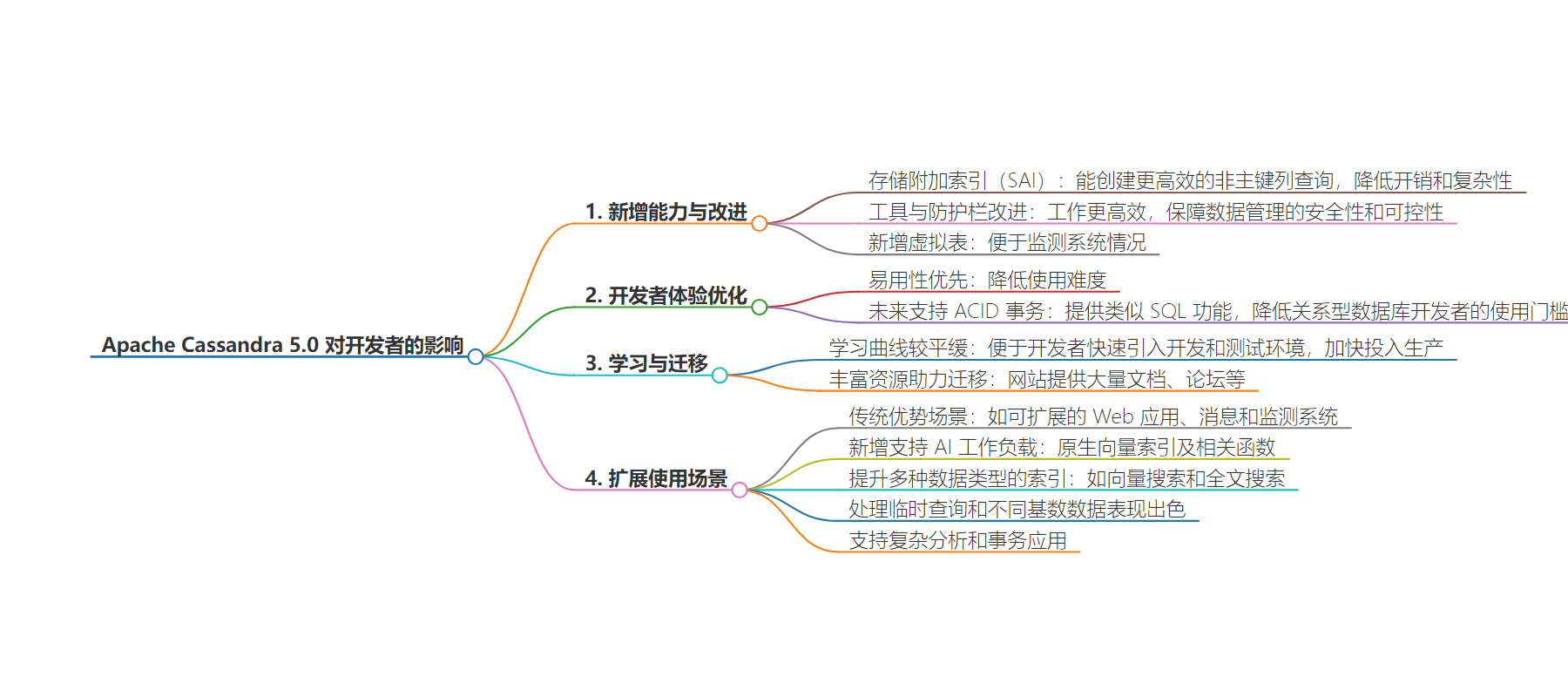包阅导读总结
1.
“`
Apache Cassandra 5.0、Developers、NoSQL Database、Improvements、Use Cases
“`
2.
Apache Cassandra 5.0 处于开放测试阶段,即将正式发布。它为开发者带来诸多新特性和改进,包括更高效的索引、优化的开发体验等,降低了学习和迁移难度,拓展了使用场景,适用于更多复杂应用。
3.
– Apache Cassandra 5.0 新特性
– 存储附着索引(SAI)让非主键列查询更高效
– 工具和防护栏改进,保障数据管理的安全与控制
– 新增虚拟表用于监测系统低点
– 开发体验提升
– 优先考虑开发者易用性
– 预计 5.1 版本将支持 ACID 事务,类似 SQL 功能降低入门门槛
– 学习与迁移
– 学习曲线变缓,便于引入开发和测试环境
– 丰富资源助力首次迁移,官网提供文档、论坛等
– 拓展的使用场景
– 新增原生向量索引,适用于 AI 工作负载
– SAI 增强多种数据类型索引,提升查询性能
– 支持复杂分析和事务应用
思维导图:
文章地址:https://thenewstack.io/why-apache-cassandra-5-0-is-a-game-changer-for-developers/
文章来源:thenewstack.io
作者:Anil Inamdar
发布时间:2024/6/23 21:24
语言:英文
总字数:763字
预计阅读时间:4分钟
评分:82分
标签:apache cassandra,数据库,开发者,nosql,AI工作负载
以下为原文内容
本内容来源于用户推荐转载,旨在分享知识与观点,如有侵权请联系删除 联系邮箱 media@ilingban.com
The release of open source Apache Cassandra 5.0, now in open beta with GA expected soon, adds several capabilities that make the NoSQL database even more compelling for enterprises’ mission-critical use cases. Zooming in on the developer level, those new features provide an especially inviting playground for teams to do interesting and groundbreaking work, including, of course, generative AI initiatives.
Cassandra 5.0 also introduces a few improvements to the developer experience itself, making it more efficient — and, frankly, enjoyable — for developers working with the database.
Let’s dig into some of the most important changes in Cassandra 5.0 and how they affect developers.
The Most Developer-Friendly Cassandra Yet
The active open source community behind the Apache Cassandra project made developer ease of use a priority. For example, the new storage-attached indexes (SAI) feature allows developers to create more efficient queries on nonprimary key columns and use secondary indexes with less overhead and complexity than prior versions.
Cassandra 5.0’s improved tooling and guardrails also enable developers to work faster with greater security and control in managing data. Those new guardrails prevent operations that risk introducing misconfigurations and feature other restrictions designed to make maintaining data consistency simple. As another example, a newly added virtual table for monitoring system lows makes it easier for developers to do their jobs well.
It’s worth noting that Cassandra promises to continue this trend toward improving its developer experience: Cassandra 5.1 is expected to add support for ACID transactions. That will enable SQL-like functionality and ease the barrier of entry so developers accustomed to relational databases can feel at home.
A Gentler Learning Curve and Easier On-Ramps to Migration
As Cassandra 5.0’s new features motivate increased adoption, developers will find that there is still a learning curve to overcome but one that’s less steep than with previous versions. I expect developers to be relatively quick in introducing Cassandra 5.0 into dev and testing environments, which will in turn enable deployments to reach production environments faster.
Cassandra 5.0 will attract folks looking to migrate to the database for the first time, and developers will also find tremendous resources available to tap into. The Apache Cassandra 5.0 website offers extensive documentation, as well as forums for interacting with Cassandra’s community. Mailing lists, town halls, contributor meetings and other events also offer valuable opportunities to dive deep into best practices.
Expanded Use Cases
Planet Cassandra is another valuable resource that developers can explore to study existing use cases and strategies. Traditionally, Cassandra has excelled at use cases like scalable web applications, and messaging and monitoring systems that leverage the database’s powerful write throughput and ability to handle large data volumes. Cassandra 5.0 continues to offer those advantages and support those use cases while also introducing features that will expand its use on several other fronts.
Perhaps chief among these, Cassandra 5.0’s addition of native vector indexing — a new vector data type for handling embedding vectors — and related new Cassandra Query Language functions now position the database as an ideal option for AI workloads. Developers working on AI application use cases require a scalable and performant vector database to handle the vast “intelligent data” it takes to give AI models their intelligence, minimize hallucinations and deliver reliable experiences. Cassandra 5.0 now offers the intelligent data infrastructure developers seek, with the Apache Cassandra project itself acknowledging its move toward an AI-driven future.
The aforementioned storage attached indexes are another Cassandra 5.0 addition that enhances indexing for numerous data types, including some related to AI use cases such as vector search and full-text search. SAI raises the bar on Cassandra query performance by handling multiple column indexes simultaneously with no impact on scalability. SAI therefore acts as an advanced filtering engine that makes maintaining multiple query-specific tables less necessary, enabling use cases such as data modeling and supporting client applications while reducing data copies (therefore using much less disk space and simplifying data security).
SAI also makes Cassandra 5.0 a particularly versatile and powerful indexing solution with superior handling of ad-hoc queries and high or low cardinality data, offering superior performance even when working with unanticipated or evolving query patterns.
Finally, Cassandra 5.0 enables developers to harness the flexibility of NoSQL while meeting the challenging requirements of today’s most data-intensive enterprise applications. Make no mistake about it, Cassandra 5.0 is more ready than ever to support use cases involving more complex analytical and transactional applications.
YOUTUBE.COM/THENEWSTACK
Tech moves fast, don’t miss an episode. Subscribe to our YouTubechannel to stream all our podcasts, interviews, demos, and more.
